Disclaimer: This information is provided as-is for the benefit of the Community. Please contact Sophos Professional Services if you require assistance with your specific environment.
Table of Contents
- Introduction
- Overview
- Prerequisites
- Configuration steps in AWS console
- Caveats and additional information
Introduction:
In this document, we'll be talking about how to deploy the Sophos firewall in Fault Tolerance a.k.a. AA (Active-Active) mode on the AWS platform. We will be using the Amazon transit gateway (TGW) feature to support the Hub and Spoke model for this deployment.
Overview
The transit gateway is used to facilitate node redundancy for the Sophos Firewalls and BGP is used to communicate the routing information with the rest of the AWS infrastructure in the customer account.
If you are interested and want to know more about this technology, check out Amazon's documentation on Transit gateway: https://aws.amazon.com/transit-gateway/
Sophos Firewall is available from the AWS marketplace for both High Availability and Fault Tolerance methods of deployment, however in this document we will be focusing on Fault Tolerance (AA) deployment method.
It is recommended to deploy the Sophos Firewall nodes in a separate VPC for traffic management and routing purposes.
While it is certainly possible to deploy the firewalls into the same VPC as other backend workloads, it will require different instructions for the TGW attachment and route table creation. Hence feel free to contact your Sophos account representative if your setup requires a single VPC deployment.
Prerequisites
- A valid AWS account to deploy Sophos Firewall.
- Also, make sure that the Transit Gateway Connect feature is available in the required AWS region and you can confirm the same from the AWS FAQ document link: https://aws.amazon.com/transit-gateway/faqs
- For BYOL deployments, pre-register for free 30 days trial serial keys using the following link, because entering the serial key is a mandatory step during the BYOL HA deployment process:
https://www.sophos.com/en-us/products/next-gen-firewall/free-trial
If you already have the serial keys or are using the PAYG licensing option, then you can skip this step. - Access to Sophos Central account. If you do not have a Central account, you can create a new one by following the steps mentioned in the link below:
https://docs.sophos.com/central/customer/help/en-us/GettingStarted/CreateAccount/index.html
Network diagram
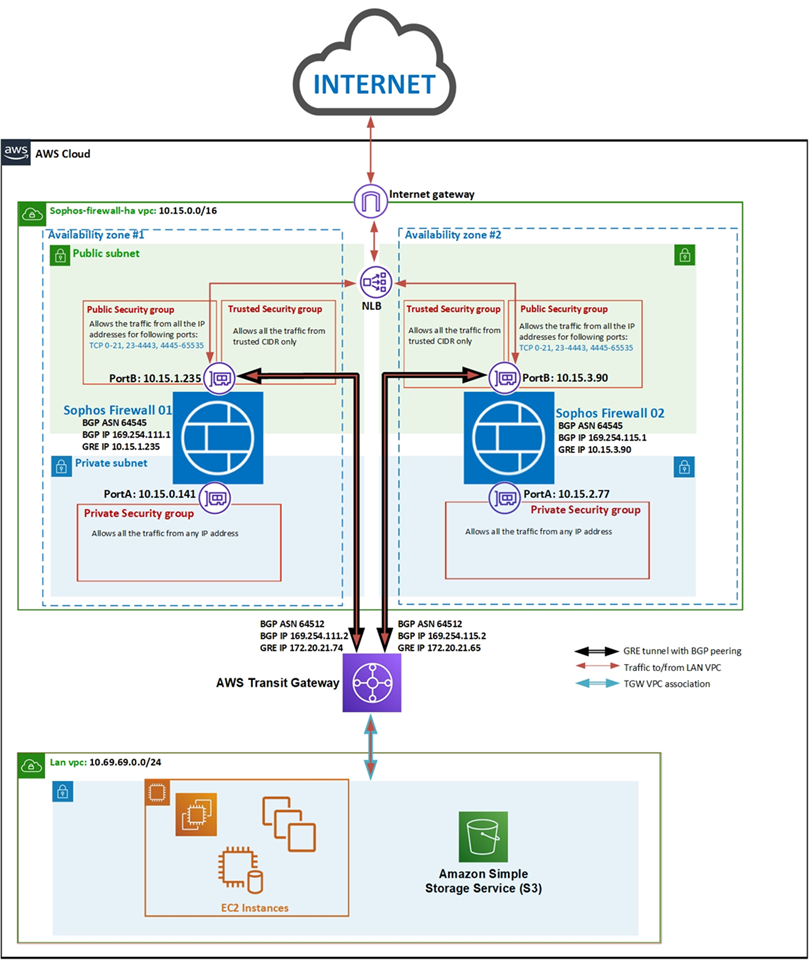
Here is the network diagram that we’re considering for this deployment. Both the Sophos firewall instances will be deployed in a separate VPC, connecting with the LAN network VPC via the transit gateway.
Note: The IP addresses used in this setup and document are for demo purposes. You can always use other IP addresses in your deployment scenario.
Configuration steps in the AWS console
Sophos Firewall instances deployment
1. (Optional, if you already have a key pair created in your account.) Once logged into your AWS web console, click Services > EC2 and scroll down to click Key Pairs.
Click the Create Key pair button, enter an appropriate name, select ppk, and finally click the Create Key pair button to automatically download the private key to your computer, which can be later used to access the Sophos firewall instance via SSH.
2. Access the GitHub repository using the link below:
https://github.com/sophos-iaas/aws-cf-templates/blob/master/xg/README.md
3. Under the High Availability / TGW section you can see two deployment options available:
Pay As You Go (PAYG) and Bring Your Own License (BYOL).
For this document, we are considering the BYOL option, so click on the Launch Stack button.
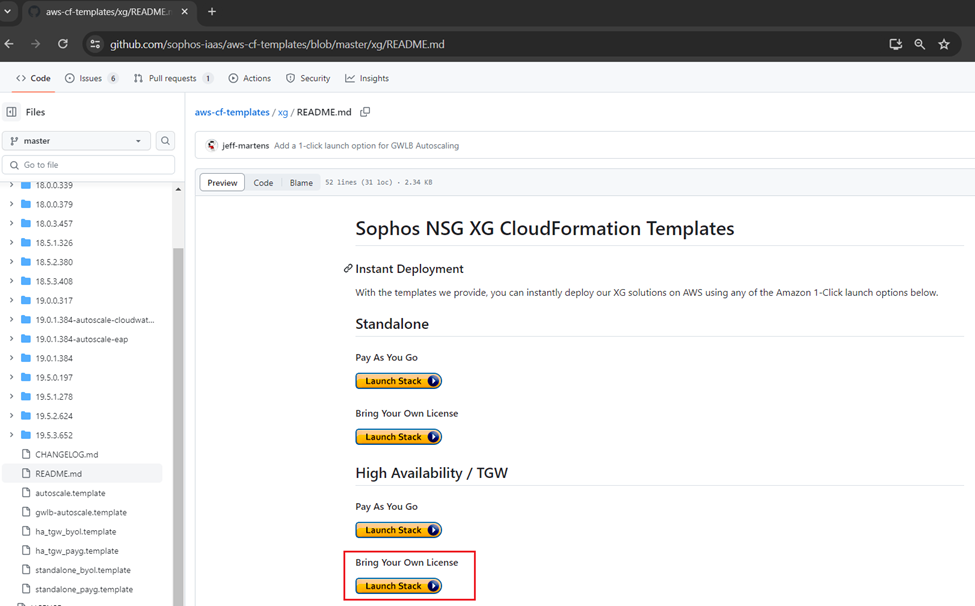
4. This will open your AWS web console and redirect to the CloudFormation stack page with S3 URL referring to the HA deployment template. Click the Next Button

5. Enter an appropriate stack name, keep the AMI ID as autodetect, and select the required instance size from the drop-down list.
Select Availability zones for each firewall node and make sure that both have different AZs selected to achieve High Availability.
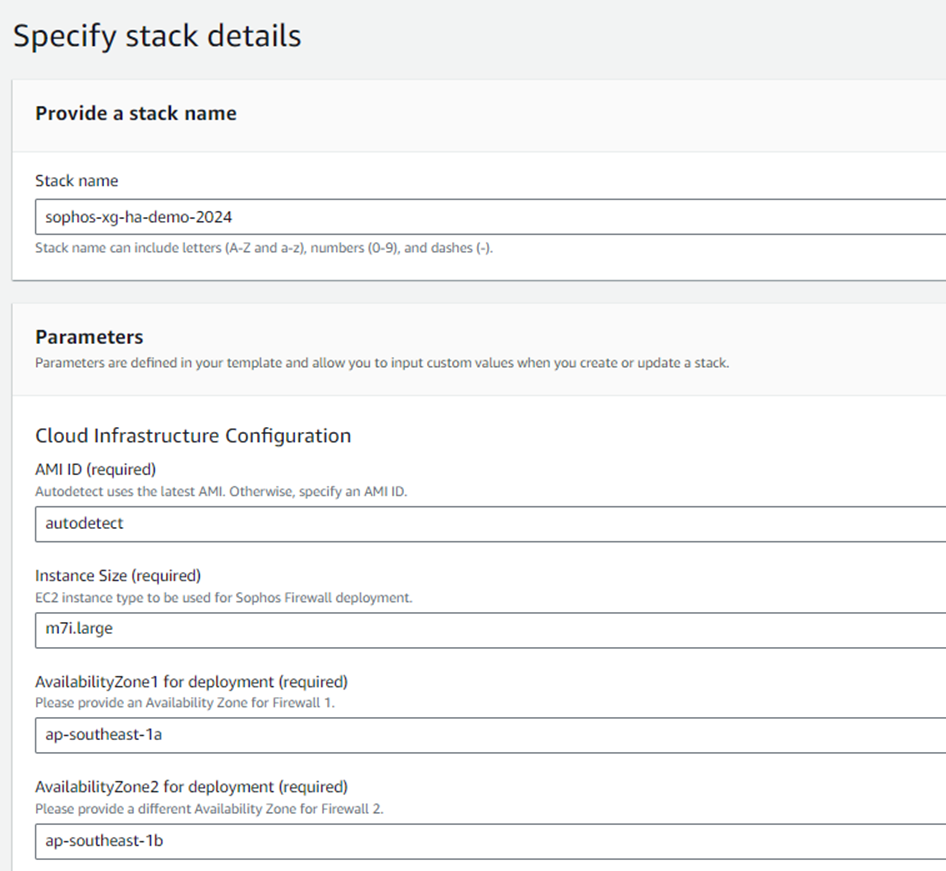
6. Configure the network address for the new VPC. You just need to enter the first two octets of the network IP. We’ll use the default network address 10.15 in this deployment.
Enter the public IP address of the administrator deploying this firewall in the Trusted network CIDR This IP address will have full management access (SSH and Web Console) to both the Sophos Firewall units.
Enter the Public Network as 0.0.0.0/0 or you can enter a specific IP address that will have access to all the ports from outside except the management port 22 and 4444. Enter a desired BGP ASN to represent the Amazon Transit Gateway in the communication with the firewall (default value is 64512, it doesn't need to be changed unless this ASN is already used somewhere in your BGP setup).

7. Enter the serial numbers of your registered licenses in the ‘Sophos Firewall Serial Numbers’ field in a comma-separated format (for example 123456789,23467890).
Enter the name of the firewall EC2 instances and this name will also be used as their hostname.
Enter the admin password of your choice matching with the password complexity policy for the remote access of firewall instances.
Enter the configuration backup password and Secure Storage Master Key (SSMK).
Enter the email ID of your Sophos Central account and its password. Both the firewalls would be managed from this central account for firewall management policies and other configurations.
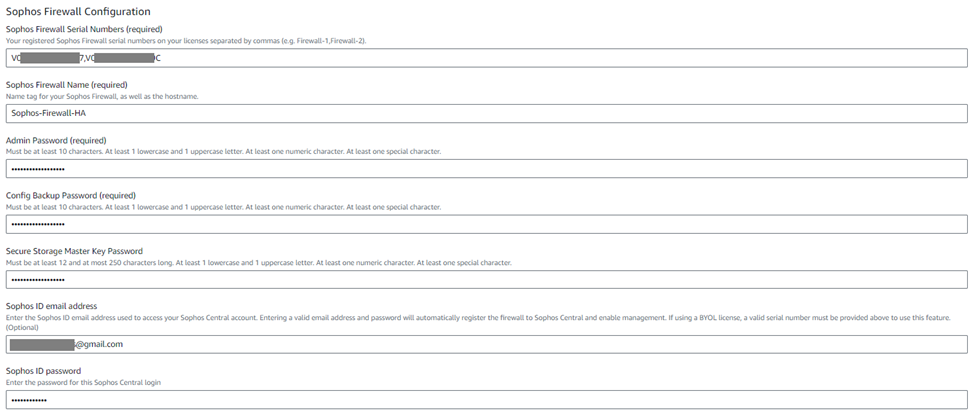
8. The S3 bucket name is an optional field, and this can be used for the backup-restore process. You can leave this field as blank.
Then select the SSH keypair that was created previously in step #1.
The logs of Sophos Firewall EC2 instances can be stored in CloudWatch and if you wish to have this functionality enabled, then select yes from the drop-down list.
Enter "yes" in the End User License Agreement field after reading and agreeing to the terms and conditions of Sophos EULA and privacy policy.
Now, if you wish to opt for the customer experience improvement program, you can select "on" option from the drop-down menu or select the ‘off’ option. We’ll select On and click Next.

9. Optionally, you can add Tags for this deployment or leave the fields as-is.
For the demonstration purpose in this article, we will add OwnerName, OwnerEmail and Department tag for this CloudFormation stack deployment and click Next.

10. Read through the deployment configuration summary, then enable the checkboxes for allowing IAM resources creation permission and finally click the Submit button

11. It will show the progress of the stack deployment for both the firewall instances and the resources associated with it. After 15-20 minutes, it’ll show the status as Create Complete which means that both the firewall instances have been deployed successfully.

AWS Transit Gateway configuration steps:
1. Navigate to Services > VPC and scroll down all the way to the Transit Gateways section and click Transit Gateways. Select the transit gateway configured by the CloudFormation stack, and from the Actions section, click Modify.

2. For the Transit gateway CIDR blocks, click the Add CIDR button and enter a suitable IPv4 network range with a /24 or larger CIDR block that you wish to use for the GRE tunnels between the Sophos firewall nodes and the Transit gateway. Click Modify Transit Gateway to save the changes.

3. Navigate to Transit Gateway Attachments and click Create Transit Gateway Attachment.
Select the correct transit gateway from the dropdown menu and make sure that VPC is selected as the Attachment type.
Enter a name that will help you recognize the connection in the Attachment Name tag
Select the Sophos Firewalls’ VPC from the VPC ID drop-down menu and make sure to select the public-facing subnets of both the firewall nodes in the Subnet IDs section.
Click Create attachment to complete this transit gateway attachment creation process.
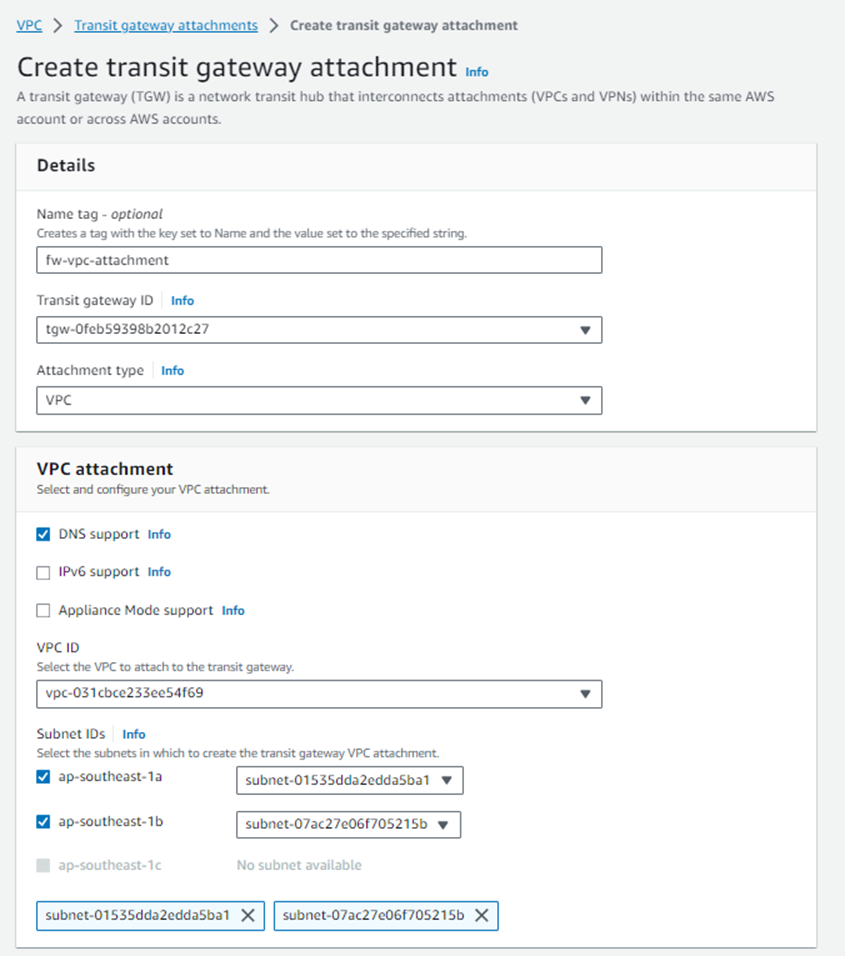
4. Similarly create the Transit gateway attachments for LAN VPC and any other VPC also that needs the connectivity with the Sophos Firewall instances via the AWS Transit gateway service

5. After all the transit gateway attachments have been created for the required VPCs, click Create Transit Gateway Attachment and select the same transit gateway ID. Make sure to select the Attachment type as Connect.
Enter a name that will help you recognize the connection in the Attachment Name tag
Select the Sophos Firewalls’ local VPC from the Transport Attachment ID drop-down menu and click Create Transit Gateway Attachment.
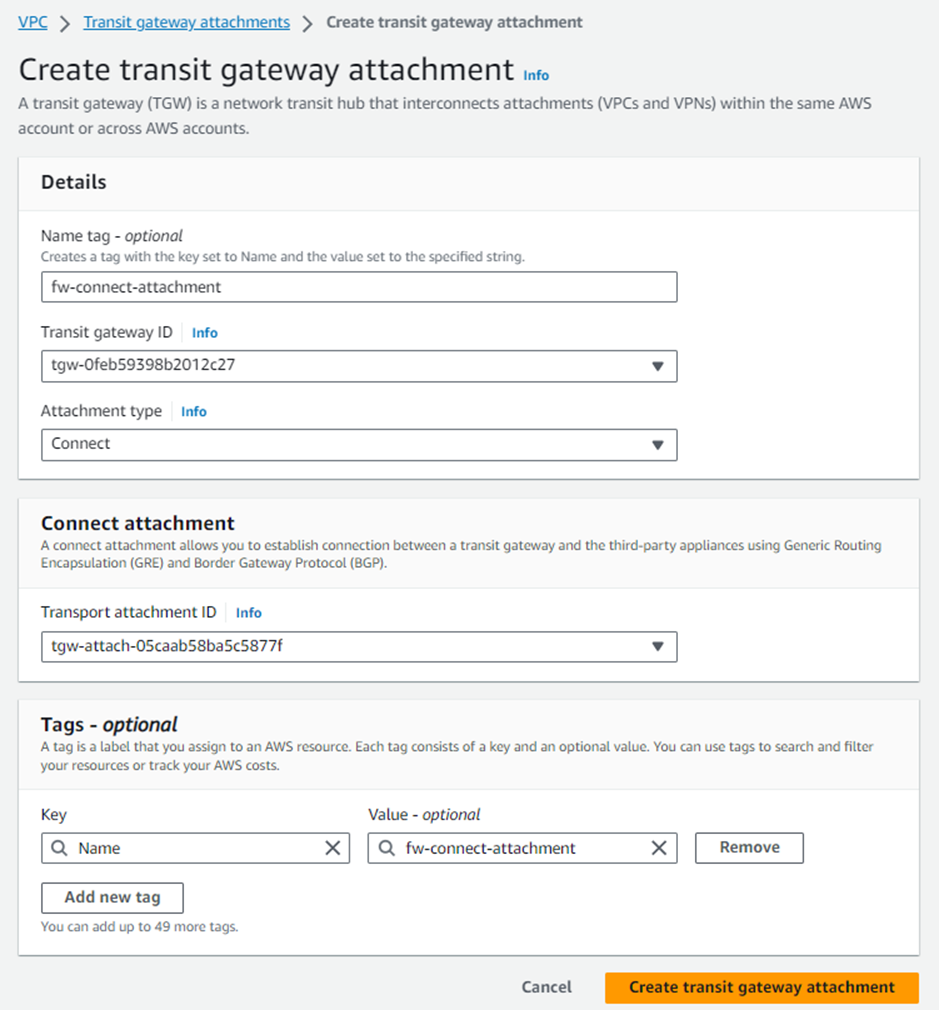
6. Select the newly created Connect attachment from the list, navigate to the Connect peers tab and click Create connect peer.

7. Enter an appropriate name in the Name tag field and keep the Transit Gateway GRE address as Auto-generated unless you wish to use a specific IP address in the CIDR block we previously attached to this transit gateway.
Enter the WAN network adapter IP address of Sophos Firewall 01 in the Peer GRE address field
Set the IPv4 subnet you want to use inside the GRE tunnel by entering it in the BGP Inside CIDR blocks IPv4 field.
Note: This block needs to be exactly /29 large and part of the non-excluded sections of the 169.254.0.0/16 subnet. For more details, see: https://docs.aws.amazon.com/vpc/latest/tgw/tgw-connect.html
Peer ASN as the Sophos firewall's ASN used for BGP peering and finally click Create. This will be configured in BGP section of Sophos firewall later.
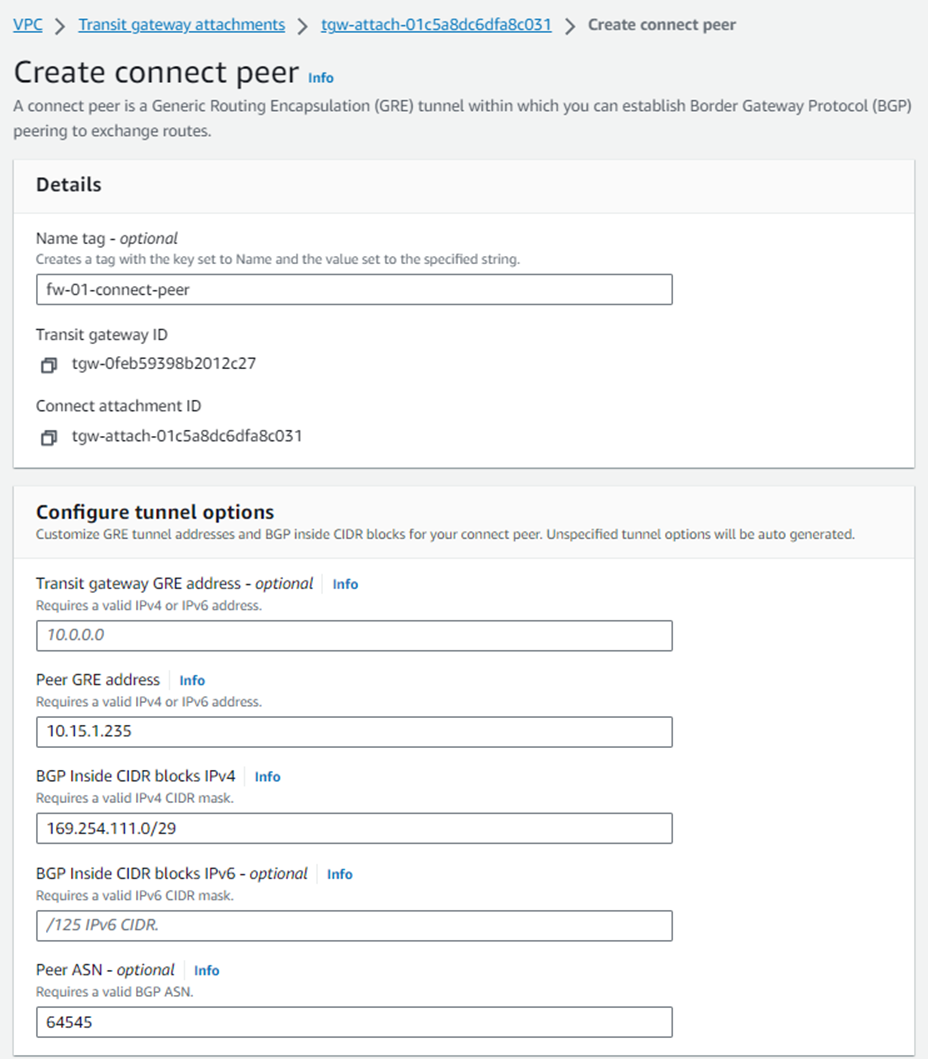
8. Create Connect peer for Sophos Firewall 02 by following the same steps as mentioned in step #7.
Ensure that the Peer ASN value is same as entered for Sophos firewall 01, so that it’ll be implemented as AA (Active-Active) deployment solution.

9. After both the connect peers have been configured, it will show the GRE and BGP related details which can be used later as a reference while configuring GRE tunnel and BGP peering in both the Sophos firewall nodes.

10. Navigate to Transit Gateway Route Tables and click Create Transit Gateway Route Table to create a new table.

Enter a name for the table in the Name tag field and select the Transit Gateway used for the attachments earlier from the Transit Gateway ID drop-down menu and click Create Transit Gateway Route Table.

11. Select the Transit Gateway Route Table from the list and navigate to the Associations tab and click Create Association.
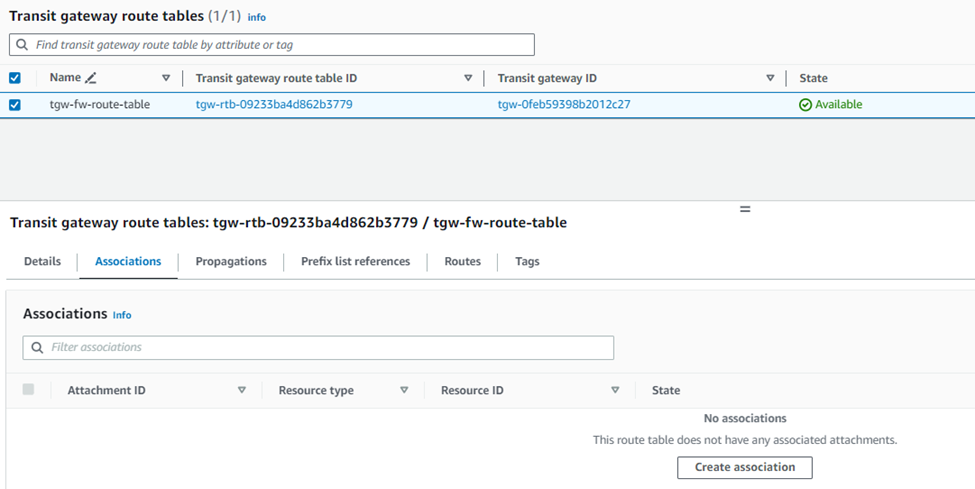
12. Select the VPC attachment for the Sophos Firewall created in step # 3 and click Create association.

13. Similarly, create another association and select the firewall’s connect attachment created previously in step #5.

After this configuration, you will see two associations under this route table.
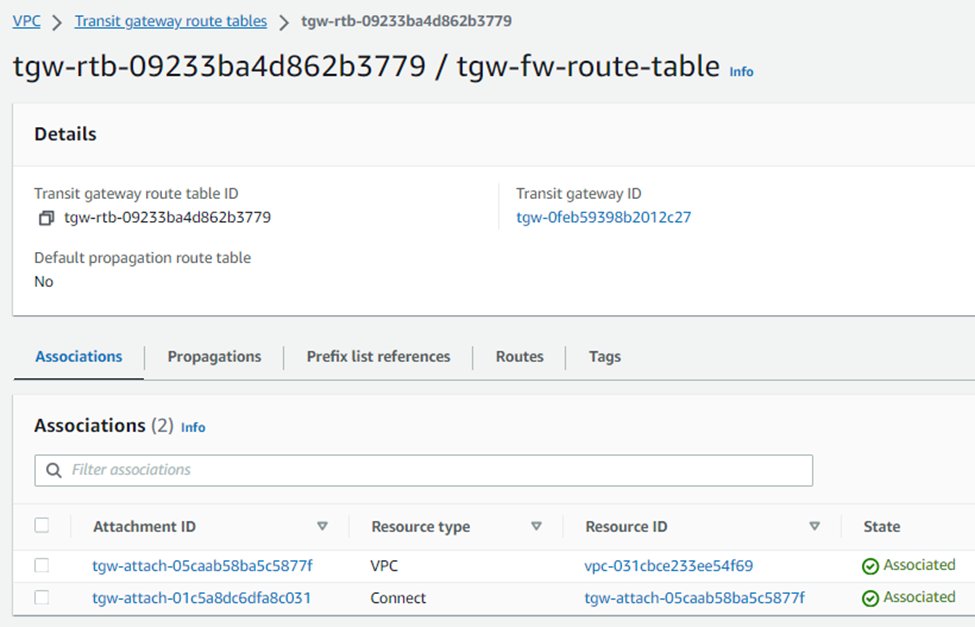
14. To enable the Sophos Firewall to receive routing information from other VPCs, IPsec tunnels, and Connect tunnels, you will need to add them on the "Propagations" tab:
- Navigate to the Propagations tab.
- Click Create propagation.
- Select the relevant internal LAN VPC, VPN, or Connect tunnel from the Choose attachment to propagate drop-down menu.
- Click Create Propagation to complete propagation creation.
Repeat the above sub-steps for each additional attachment you wish to propagate to the Sophos Firewall via TGW.
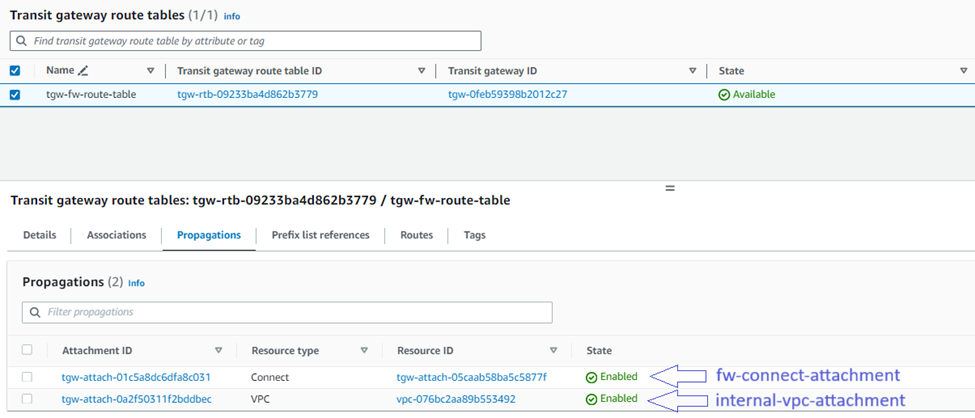
15. To enable other VPCs, VPN and Connect tunnels to receive routing information from the Sophos Firewall you will need to:
Create a new transit gateway route table and select the internal LAN VPC
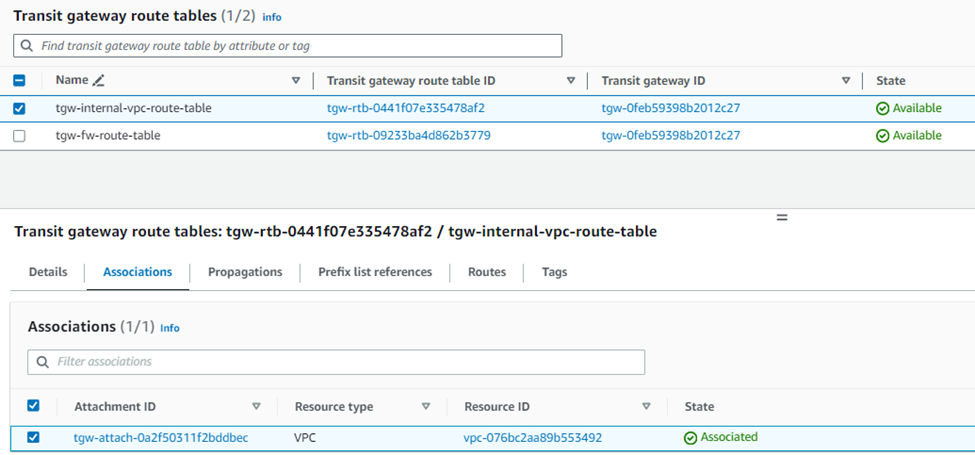
- Navigate to the Propagations tab on the newly created Route Table.
- Click Create propagation.
- Select the firewall Connect tunnel from the Choose attachment to propagate drop-down menu and click Create propagation to complete propagation creation.
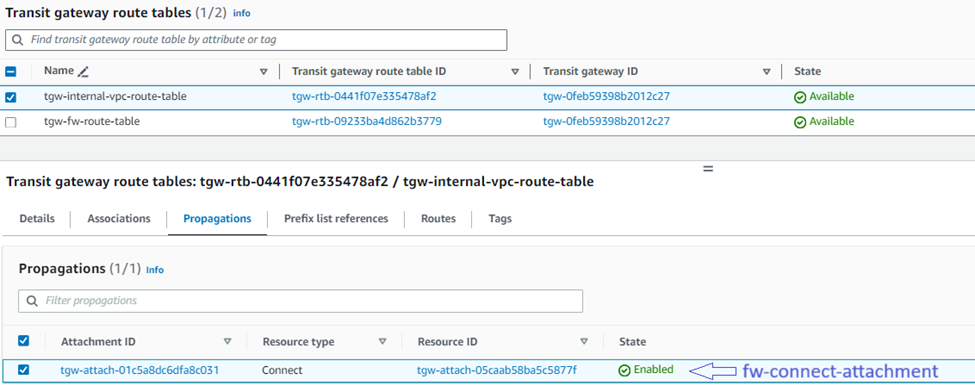
16. Navigate to the Virtual Private Cloud in the left-hand menu and select Route Tables.
Locate the route table associated with the Sophos Firewalls' WAN subnet
(This information can be found by selecting a route table associated with the firewall's VPC and checking the Subnet Associations tab).

17. Click on the Routes tab and then click Edit routes.

18. Click Add route and enter the Transit gateway CIDR.
Select the TGW created by CloudFormation in the Target list and click Save changes.

19. In order to force other subnets to route their traffic through the TGW, you’ll need to edit their subnet route tables to send relevant traffic to the gateway. To do so:
- Locate the relevant route table.
- Open the Routes tab and click Edit routes.
- Click Add route and enter 0.0.0/0 as the subnet value (this scenario assumes that all traffic needs to be sent to the TGW to enable additional filtering. Use a specific subnet range if this is not the case for your setup).
- Select the TGW created by CloudFormation in the previous section from the Target list
- Click Save routes to store the route table.
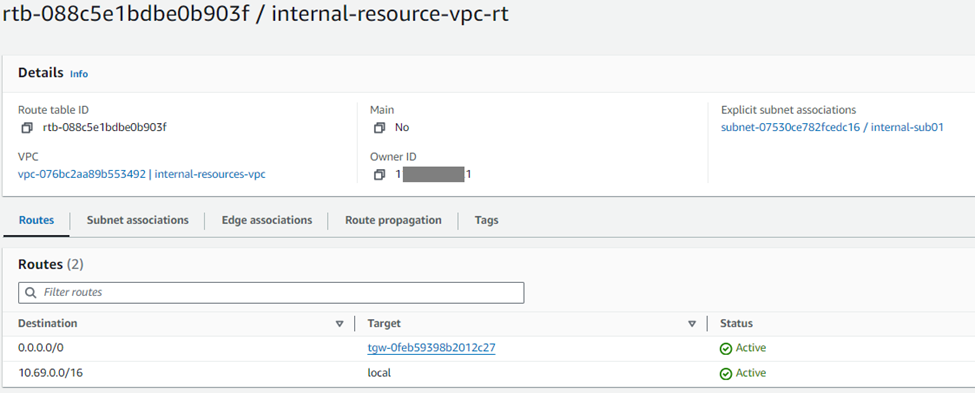
With the new Connect configurations created, the next step is to configure the Sophos Firewall nodes with the relevant GRE and BGP details.
I. In your AWS console, navigate to Services > VPC.
II. Navigate to Transit Gateway Attachments in the left-hand menu.
III. Select the Connect attachment for the Sophos Firewall node and navigate to the Connect peers tab.
IV. Note the address information in the following fields for both the entries that will be required to configure the Sophos firewall nodes:
a. Transit Gateway GRE address.
b. Peer BGP address.
c. Transit Gateway BGP 1 address.

Configuration steps in Sophos Firewall:
1. In AWS console, navigate to Services > EC2 and click Instances.
2. Select the first Sophos firewall and copy the Elastic public IP address of the instance.
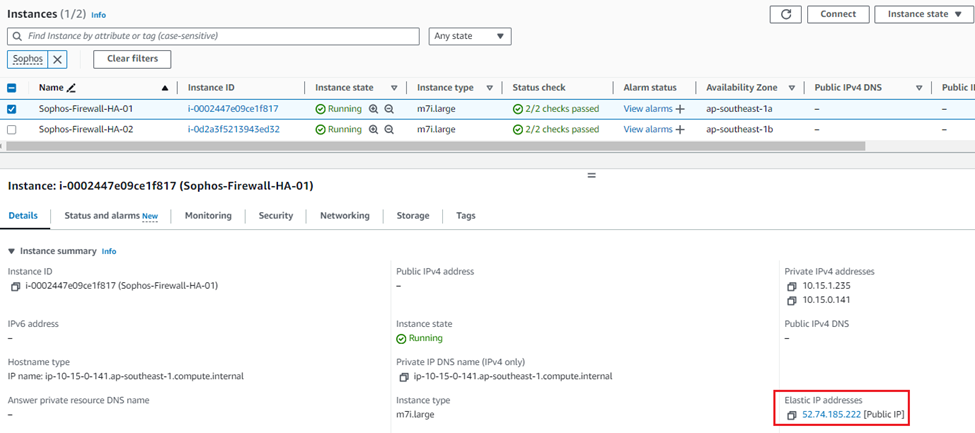
3. Open a new web browser tab and access the web console of the first firewall on HTTPS using the public IP copied in Step 2 and append the port number 4444.
Enter the admin credentials and captcha and click Login.
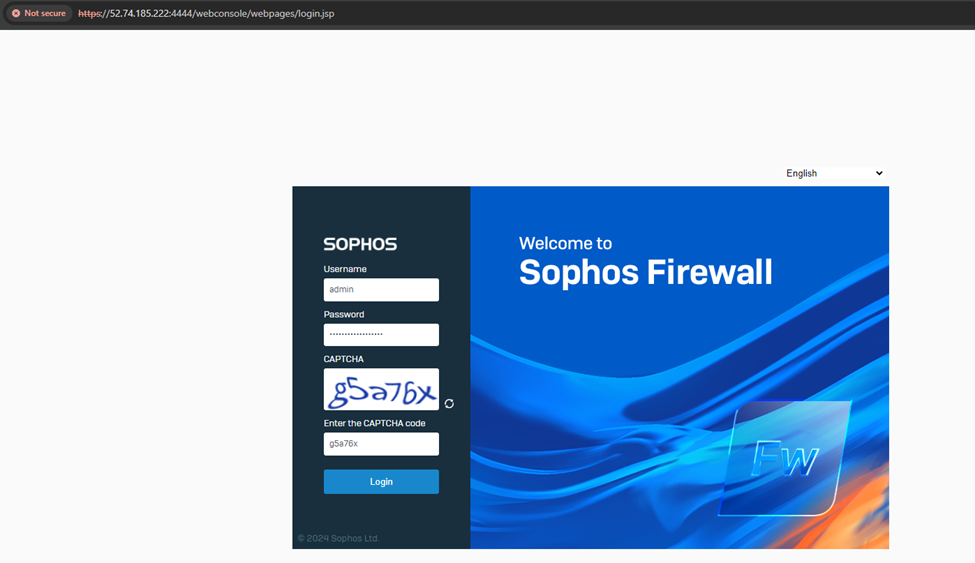
4. After logging into the device, it will go through the device claim(registration) process.
It will auto-detect the serial key that was entered previously during the CloudFormation deployment stage. Click Continue.
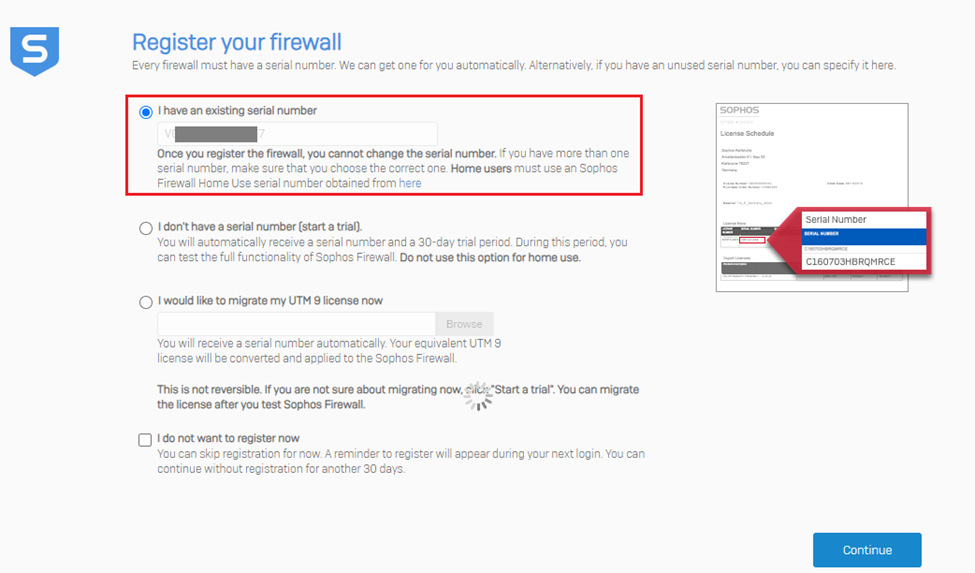
The next step is the claiming the firewall in the Sophos Central account, so click the option Claim in Sophos Central

It’ll redirect to the Sophos Central Firewall licensing page and you can claim the firewall for 30 days of trial license. Click Claim firewall.
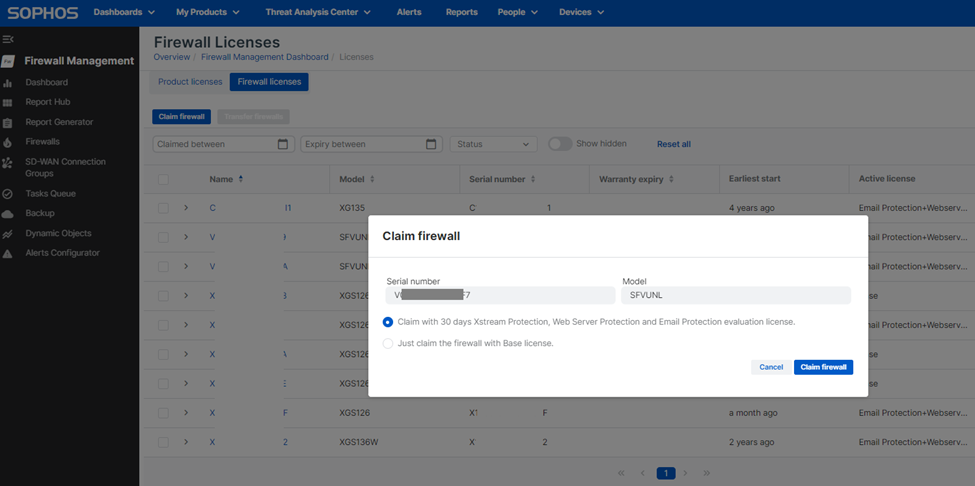
After this step, it will show the license status of the firewall instance and then click Continue to go to the Dashboard page.
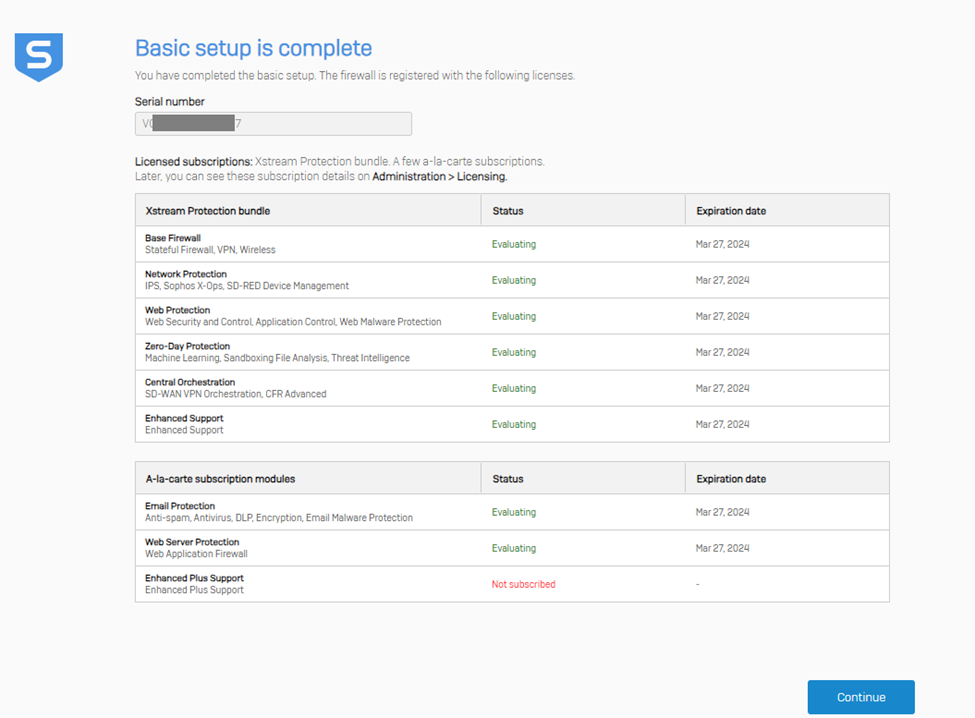
5. Navigate to SYSTEM > Administration > Admin and user settings and add -01 to the hostname of the firewall, to identify it easily from Sophos Central Firewall management section.
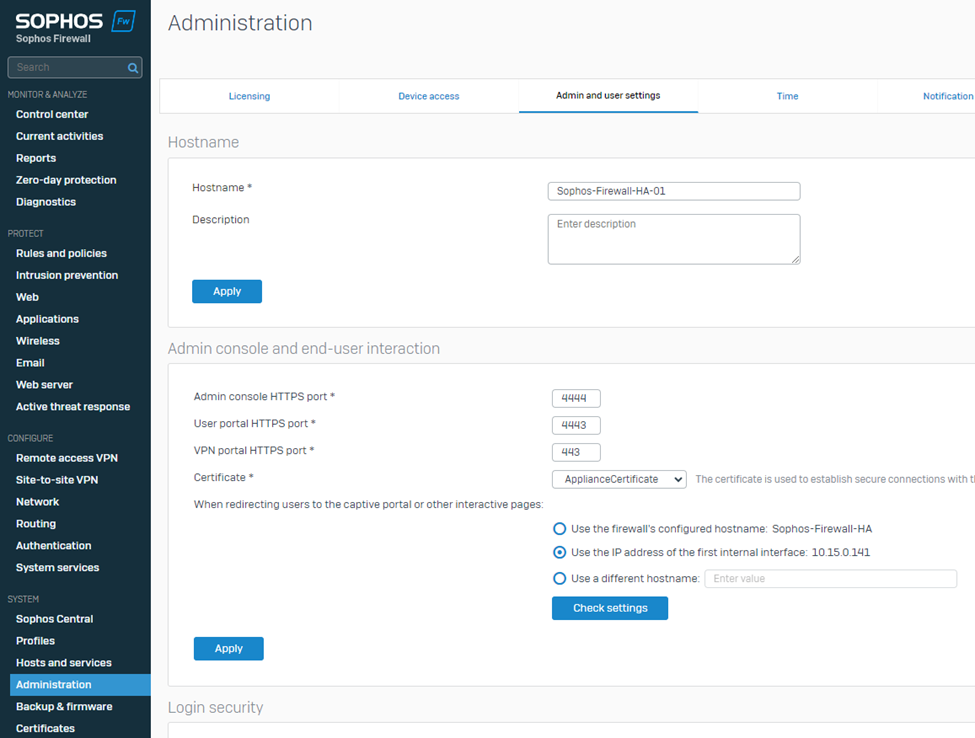
6. Navigate to CONFIGURE > Routing > BGP.
Select Route ID assignment as Manual.
Enter the Sophos Firewall's WAN adapter IP address in the Router ID field.
Enter the BGP Autonomous System number entered in step 7 of the previous section into the Local AS field.
Click Apply to save the configuration.
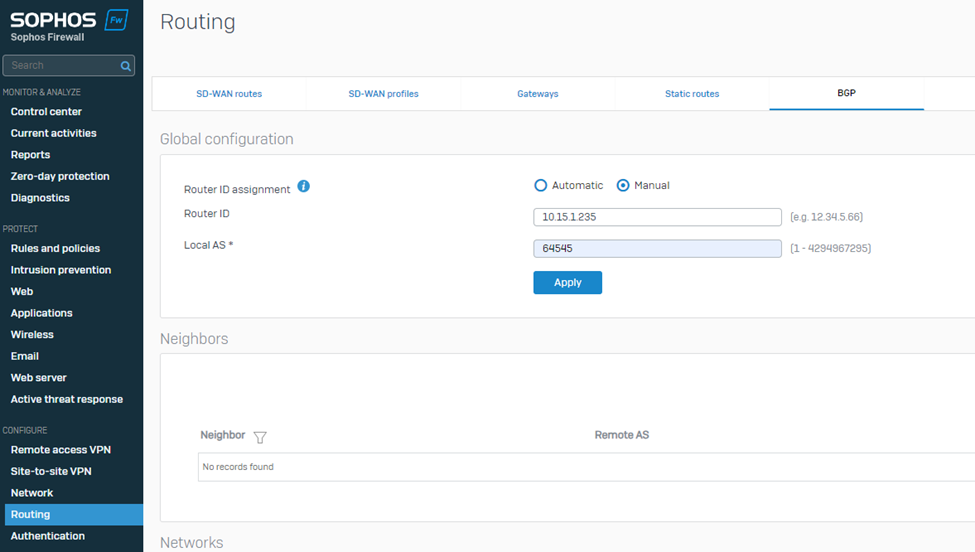
7. Navigate to the Neighbors section and click Add.
Select the IP version as IPv4.
Enter the IP address listed under Transit Gateway BGP 1 from step IV into the IPv4 address field.
Enter the Remote AS as the ASN used by the Transit Gateway.
Click Save to store the neighbor settings.

8. Navigate to PROTECT > Rules and policies > Firewall rules and make sure to create relevant firewall rules with action Allow, so that the traffic can traverse successfully via the Sophos firewall

9. Navigate to System > Administration >Device access and enable Dynamic Routing option for the VPN zone.
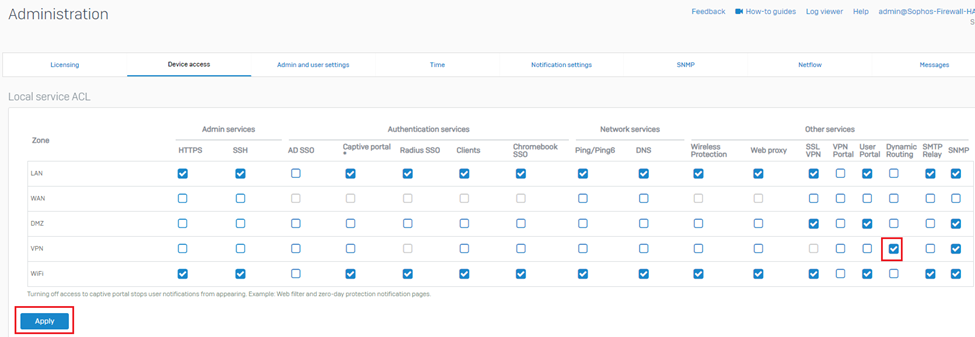
10. Set up a remote shell session of SSH with the Sophos Firewall via the elastic public IP and sign in using the admin username and its password.

11. Select option 4. Device console.
Enter the following command (replacing the sections between <> with the details found in step IV): "system gre tunnel add name TGW01 local-gw PortB remote-gw <Transit Gateway GRE address> local-ip <Peer BGP address> remote-ip <Transit Gateway BGP 1 address>".

After the command is executed successfully, type exit to return to the main menu.
12. Select option 3. Route Configuration, followed by 1. Configure Unicast Routing and 3. Configure BGP.
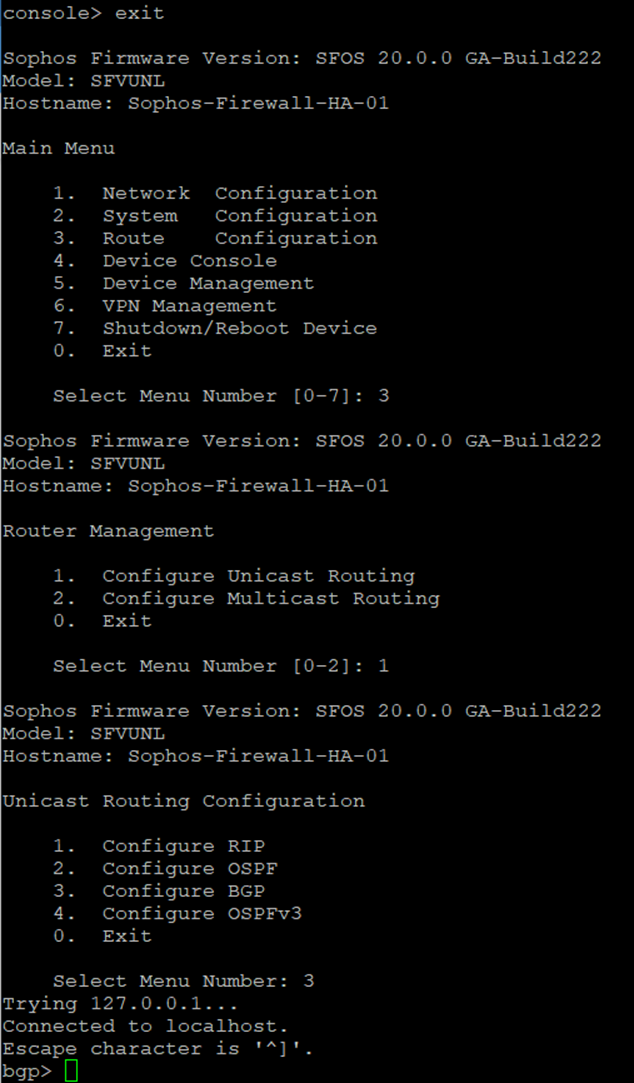
Enter the following commands to establish BGP neighbourship with Transit Gateway via GRE tunnel:
bgp> enable
bgp# configure terminal
bgp(config)# router bgp <This Firewall's ASN>
bgp(config-router)# neighbor <Transit Gateway BGP 1 IP> ebgp-multihop 2
bgp(config-router)# neighbor <Transit Gateway BGP 1 IP> activate
bgp(config-router)# neighbor <Transit Gateway BGP 1 IP> default-originate
bgp(config-router)#write

13. Type exit to return to the previous configuration level. Repeat until you return to the main menu.
Select 0. Exit and repeat until the SSH session is closed
14. To verify whether the BGP neighbourship is established, check the BGP summary by navigating to CONFIGURE > Routing > Information > BGP.
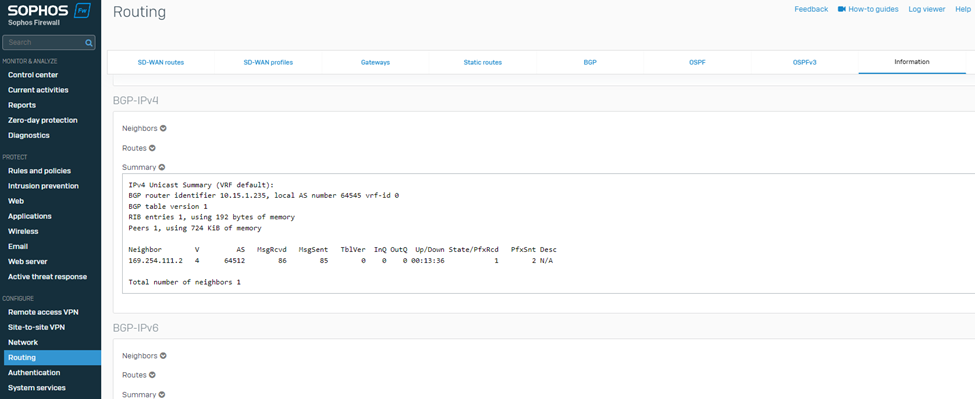
Similarly on the AWS Web console, it will show the status of BGP1 IP address as Up.

This completes the configuration of Sophos Firewall 01.
15. Access the Sophos Firewall 02 using its elastic IP address and complete the claim(registration) process.
You can repeat instructions of steps #1 to 4 using Sophos Firewall 02 public IP.
16. Update the hostname of this firewall by adding -02.

17. Configure BGP on the Firewall 02 as follows:


18. Navigate to PROTECT > Rules and policies > Firewall rules and make sure to create relevant firewall rules with action Allow, so that the traffic can traverse successfully via the Sophos firewall.

19. Navigate to System > Administration >Device access and enable Dynamic Routing option for the VPN zone.
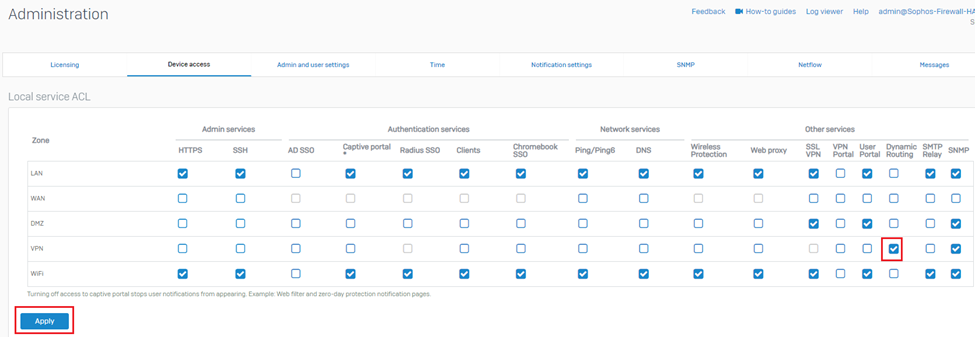
20. Set up a remote shell session of SSH with the Sophos Firewall via the elastic public IP and sign in using the admin username and its password.
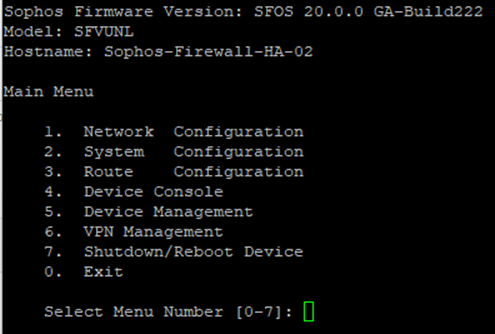
21. Select option 4. Device console.
Enter the following command (replacing the sections between <> with the details found in step IV): "system gre tunnel add name TGW01 local-gw PortB remote-gw <Transit Gateway GRE address> local-ip <Peer BGP address> remote-ip <Transit Gateway BGP 1 address>"
![]()
After the command is executed successfully, type exit to return to the main menu.
22. Select option 3. Route Configuration, followed by 1. Configure Unicast Routing and 3. Configure BGP.
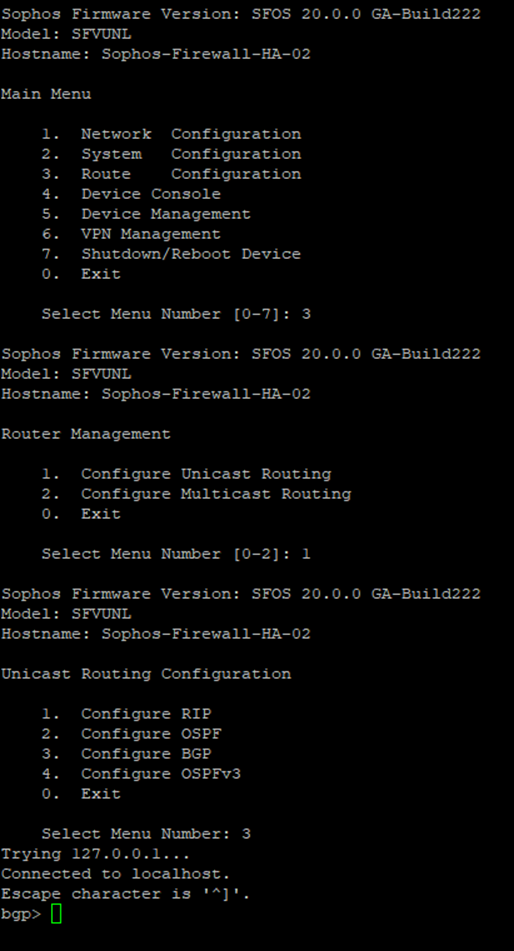
Enter the following commands to establish BGP neighbourship with Transit Gateway via GRE tunnel:
bgp> enable
bgp# configure terminal
bgp(config)# router bgp <This Firewall's ASN>
bgp(config-router)# neighbor <Transit Gateway BGP 1 IP> ebgp-multihop 2
bgp(config-router)# neighbor <Transit Gateway BGP 1 IP> activate
bgp(config-router)# neighbor <Transit Gateway BGP 1 IP> default-originate
bgp(config-router)#write

23. Type exit to return to the previous configuration level. Repeat until you return to the main menu.
Select 0. Exit and repeat until the SSH session is closed.
24. To verify whether the BGP neighbourship is established, check the BGP summary by navigating to CONFIGURE > Routing > Information > BGP.

Similarly on the AWS Web console, it will show the status of BGP1 IP address as Up.

This completes the configuration of Sophos Firewall 02.
Caveats and additional information
AWS Network Load Balancer configuration:
After deployment completes, the network load balancer used by the Active-Active deployment will be configured to perform a health check on the firewall nodes using port TCP 4444.
Since this port is part of the management port range affected by the Trusted Network security group, health checks are expected to fail due to the load balancer not being a part of said trusted network range.
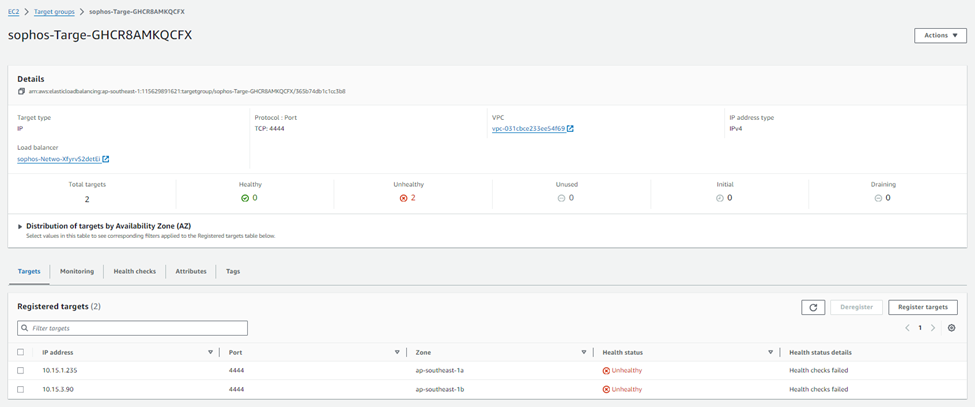
This is intentional as it avoids exposing the management ports or the load balancers to unintended traffic.
In order to make the AWS Network Load Balancer functional, we recommend modifying the existing health check to match the service port used by the content published on the firewall.
For example, if the WAF (Web Application Firewall) feature is being used to accept traffic on port TCP 443, we recommend setting the load balancer's health checks to use the same port. This ensures service delivery capabilities and health check status are aligned, making sure that failed firewall nodes are removed from service automatically.
DNAT considerations for AA deployment
For the AA (Active-Active) scenario you will need to apply source NAT(MASQ) to inbound traffic for any DNAT rule that allows traffic from the WAN zone into the environment. This enables the TGW to route traffic back to the correct Sophos Firewall instead of balancing the request over all available nodes, preventing asymmetric routing.
DNAT rule can be created from Sophos Central Firewall group so that it will be automatically pushed to both the firewall nodes.
For the demonstration purposes, we will create a DNAT rule to open RDP port 3389 as follows:
1. Login to your Sophos Central account and then navigate to My Products > Firewall management > Firewalls and you will see both the firewall nodes under the Ungrouped section.

2. Click on Create New Group button, enter the name of the firewall group, select Use Sophos default template, and then select both the firewall nodes from the Available Firewalls column and add it into the Assigned Firewalls column.
Ensure that Skip full sync tick mark is enabled for both the firewall nodes and hit the Save button.

3. Now it’ll show both the firewall nodes placed under the new group. Click on the ellipsis icon at the right side of the group and click Manage Policy.

4. This will open a new web browser tab and show the group policy configuration page. Navigate to Hosts and Services > IP Host and click Add button.
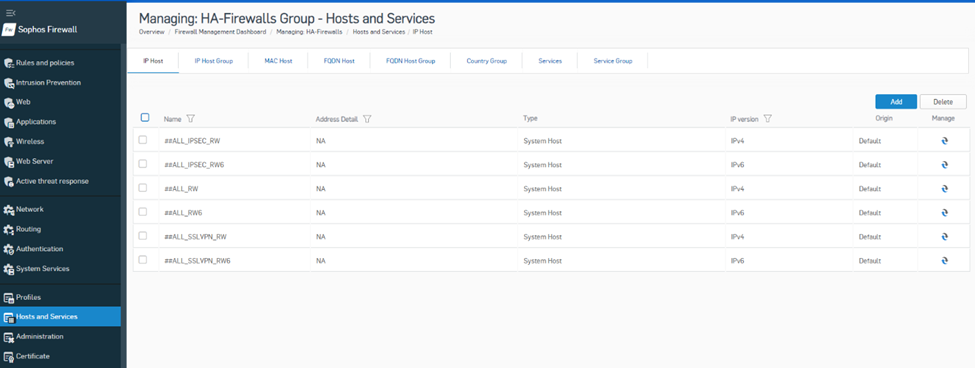
Create a new IP Host object with the Type selected as IP List and enter the private IP address of PortB of both the firewall nodes separated by ‘,’ and hit the Save button.

5. Now navigate to Rules and policies > Firewall rules and click on Add Firewall Rule > New firewall rule option.

Enter the name of the firewall rule, Rule Position as Top, Action as Accept, logging option enabled,
Source zones as WAN, Source networks as Any,
Destination zones as VPN, Destination networks as newly created IP host object, Services as RDP configured for Port 3389 and then hit the Save button.

6. Navigate to Rules and policies > NAT rules and click on Add NAT rule > New NAT rule.

Enter the name of the NAT rule, Rule Position as Top, Action as Accept,
Original Source as Any, Original Destination as IP host object and Original service as RDP,
Translated Source as MASQ, Translated Destination as the actual private IP of RDP server and Translated service as Original,
Inbound interface and Outbound interface can be kept as Any and then hit the Save button.

With this configuration in place, both the firewalls will have one firewall rule and one NAT rule that will allow RDP traffic from internet to be forwarded to the TGW and the source IP of that traffic will be Source NATed with PortB private IP, to avoid asymmetric routing.
East-West routing considerations for AA deployment
As also mentioned in the introduction discussing the models, east-west traffic requires additional provisions - similar to the DNAT considerations discussed above.
This is needed as the TGW uses the state-unaware BGP Equal Cost Multi-Pathing (ECMP) algorithm to distribute traffic over the available firewall nodes, which could cause asynchronous routing scenarios in which return traffic can't be guaranteed to return to the firewall node that processed the outgoing traffic, resulting in broken TCP sessions.
Since most companies do not want to apply source NAT (or any NAT for that matter) on traffic flowing between internal sources, you will need to enable BGP path prepending on the Sophos firewall 02 node to raise its path cost.
This causes the TGW to no longer populate both firewall nodes as viable next-hop targets into the propagated route tables, preferring to only populate the one with the lowest path cost, which ultimately enables the firewall nodes to act as an Active-Active pair for inbound and outbound north-south traffic, while operating like an active-passive HA setup for east-west traffic.
The steps involved are as follows:
- Establish an SSH session to the Sophos Firewall 02 node.
- Sign in using the admin username and the password selected during the CloudFormation section of this guide.
- Select option "3. Route Configuration", followed by "1. Configure Unicast Routing" and "3. Configure BGP"
- Enter administrative mode by entering “enable” followed by <enter>
- Enter configuration mode by entering “configure terminal” followed by <enter>
- Create a new ip prefix list that matches the subnet(s) used in the east-west communication by running “ip prefix-list internal seq 5 permit <Your east-west subnet in CIDR format>” followed by <enter> (replacing the section between <> with the subnet in question).
Repeat this for every internal CIDR block you wish to route through the Firewall nodes in an east - west communications pattern, and make sure to increment the "seq" value for each entry (seq 5 → seq 10 → seq 15, etc.). - Create a second ip prefix list for the CIDR(s) that are not part of the east-west traffic (for example the default gateway), by running "ip prefix-list external seq 5 permit 0.0.0.0/0" followed by <enter>.
- Create a new route-map and add the first entry by running "route-map <name> permit <sequence number>" where <sequence number> is an arbitrary number that indicates the priority on the list.
- Add a match statement that uses the IP prefix list we just created for the east-west subnets by entering “match ip address prefix-list internal” followed by <enter>
- Set this route map entry to prepend the AS path, which will ensure the upstream BGP router (the TGW in this case) will only select this firewall nodes’ routes for the east-west subnets if the primary firewall has failed, by entering “set as-path prepend <your AS number>” (replacing the section between <> with the ASN from step 9 of the " AWS Transit Gateway configuration steps " section) followed by <enter>
- Exit back to the configuration menu by entering “exit” followed by <enter>
- Add a new entry to the route map by running "route-map <name> permit <sequence number>" where <sequence number> needs to be higher than the first entry.
- Add a match statement that uses the IP prefix list created for the default route by entering “match ip address prefix-list external” followed by <enter>
- Exit back to the configuration menu by entering “exit” followed by <enter>
- Open the routing configuration by entering “router bgp <your AS number>” (replacing the section between <> with the ASN from step 9 of the " AWS Transit Gateway configuration steps " section) followed by <enter>
- Apply the new route map to the TGW neighbor by entering “neighbor <Transit Gateway BGP 1 IP> route-map <name> out” (replacing the section between <> with the details found in step IV of the post configuration tasks) followed by <enter>
- Exit back to the configuration menu by entering “exit” followed by <enter>
- Store the configuration by entering “write” followed by <enter>
- Exit back to the administrative menu by entering “exit” followed by <enter>

20. Go back to the interactive menu by entering “exit” followed by <enter>
21. End the SSH session by entering “0”, “0”, “0”
This concludes the Sophos Firewall AA deployment instructions in this document.
To use the security and scanning features of Sophos firewall, feel free to refer to online documentation repository available via following link:
______________________________________________________________________________________________________________________________________
RR Revamp (new doc), formatting, grammar, Added TAGs, Title
[edited by: Raphael Alganes at 4:39 PM (GMT -7) on 30 Apr 2024]

